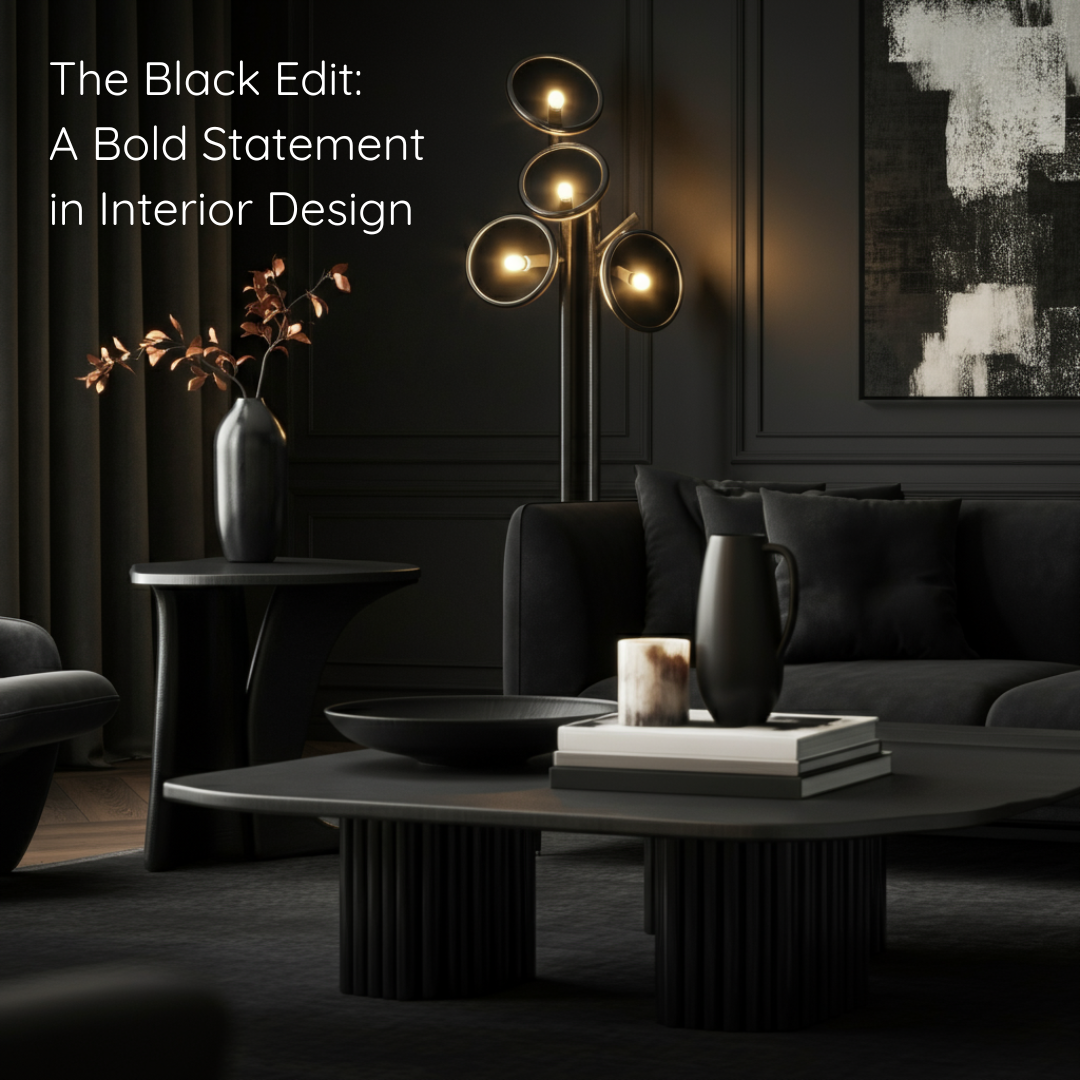Black has long held a commanding presence in the world of design. From the sleek lacquered furniture of ancient China to the dramatic gothic interiors of Victorian England, black finishes have conveyed sophistication, mystery and timeless elegance. Today, the “Black Edit” represents a contemporary design movement that embraces black-finished furniture and decorative items as statement pieces that transform ordinary spaces into extraordinary ones.
This design approach isn’t about creating dark, oppressive rooms. Rather, it’s about harnessing the power of black to add depth, contrast and visual drama to your home. Whether you’re drawn to the minimalist allure of matt black metal or the luxurious sheen of ebonised wood, understanding how to work with black finishes can elevate your interior design to new heights.
Understanding the Black Edit Aesthetic
The Black Edit style centres on incorporating black-finished furniture and decorative objects as focal points within a space. This might include ebonised wooden cabinets, powder-coated metal shelving, black-painted vintage pieces or contemporary furniture with black lacquer finishes.
What distinguishes this approach from simply painting everything black is its thoughtful, curated nature. The Black Edit involves selecting specific pieces that serve as anchors or accent points, creating visual interest through contrast rather than overwhelming a space with darkness. A black-painted chest of drawers against white walls, a cluster of black ceramic vases on a light timber sideboard or a statement black pendant light above a dining table—these are the building blocks of this aesthetic.
Historically, black furniture held particular significance in different cultures. In Japan, black lacquerware known as “urushi” was prized for its durability and beauty, often featuring intricate gold decorations. In 18th-century Europe, japanning—a technique that imitated Asian lacquerwork—became fashionable, with black finishes adorning cabinets and screens in wealthy households. Understanding this rich heritage reminds us that black finishes have always been associated with craftsmanship and refinement.
Key Considerations Before Embracing Black
Before committing to black-finished pieces, several practical factors deserve consideration.
Room size and natural light play crucial roles in how black furniture will appear in your space. Rooms with abundant natural light can accommodate larger black pieces without feeling confined. South-facing rooms with generous windows can handle bold black furniture beautifully, as the natural light prevents the space from feeling heavy. Conversely, smaller rooms or those with limited daylight require a more restrained approach—perhaps a single statement piece rather than multiple black items.
Existing colour schemes must be evaluated carefully. Black works harmoniously with numerous palettes, but the overall effect varies significantly. Paired with whites and greys, black creates a crisp, modern aesthetic. Combined with warm woods and natural textures, it offers sophisticated contrast whilst maintaining warmth. Against jewel tones like emerald or sapphire, black provides grounding weight that prevents the space from feeling frivolous.
Maintenance requirements differ depending on the finish type. Matt black surfaces show dust and fingerprints less readily than high-gloss finishes, making them more practical for frequently used pieces. However, glossy black lacquer, whilst requiring more careful maintenance, reflects light beautifully and can make spaces feel larger. Consider how much time you’re willing to invest in upkeep when selecting your finishes.
The Benefits of Black-Finished Pieces
Black furniture and decorative items offer several compelling advantages that explain their enduring popularity.
Versatility across styles stands as perhaps black’s greatest strength. A black metal bookshelf suits industrial lofts and contemporary flats equally well. An ebonised Victorian chair transitions seamlessly from traditional to eclectic interiors. This adaptability means your investment in quality black pieces remains relevant as your tastes evolve.
Creating visual depth becomes effortless with black accents. Where pale furnishings can sometimes feel flat or washed out, black introduces shadows and dimension. A black-framed mirror, for instance, doesn’t just reflect light—it creates a defined boundary that makes the reflection more striking. Black picture frames similarly draw the eye to artwork, providing definition that lighter frames cannot achieve.
Timeless sophistication never goes out of fashion. Whilst trendy colours come and go, black maintains its elegant appeal decade after decade. A well-made black cabinet purchased today will look equally appropriate in twenty years, making it a sound long-term investment.
Concealing imperfections proves particularly useful in rental properties or older homes. Black paint can disguise scratched or damaged furniture, giving tired pieces new life. Where natural wood might show every mark, black finishes offer forgiveness whilst maintaining style.
Potential Drawbacks to Consider
Honesty demands acknowledging that black finishes aren’t universally suitable.
Showing dust and marks presents the most common complaint. Fingerprints appear readily on glossy black surfaces, and dust shows starkly against black furniture in well-lit rooms. Regular cleaning becomes necessary to maintain the crisp appearance that makes black so appealing.
Overwhelming smaller spaces can occur when enthusiasm outpaces practicality. A small bedroom furnished entirely with black pieces risks feeling cave-like rather than cosy. The solution lies in restraint—one or two black items rather than comprehensive black furnishings.
Temperature perception deserves mention, though its impact varies. Some people find rooms with substantial black furniture feel psychologically cooler or more formal. This perception matters less in bedrooms or studies but might influence decisions about family living spaces.
Tips for Successfully Implementing the Black Edit
Mastering the Black Edit requires strategic thinking and careful balance.
Start with accent pieces if you’re uncertain about committing fully to black furniture. A black side table, lamp or set of shelves allows you to test how black elements work in your space without major investment. These smaller pieces can be moved between rooms as you refine your approach.
Balance with lighter elements prevents spaces from feeling heavy. For every substantial black piece, incorporate lighter counterpoints—white walls, pale timber flooring, cream upholstery or metallic accents. This interplay between light and dark creates the visual drama that makes the Black Edit so compelling.
Mix textures and finishes rather than relying on a single type of black surface. Combine matte black metal with glossy black lacquer, or pair painted black wood with black leather. These varied textures catch light differently, adding complexity and interest to your scheme.
Consider undertones when selecting black paint or finishes. Black isn’t simply black—it contains subtle undertones of blue, brown or green that become apparent in different lighting conditions. Test samples in your space at various times of day before committing to ensure the undertone complements your existing palette.
Use black to define zones in open-plan spaces. A black bookshelf or console table can subtly delineate areas without requiring walls or screens, maintaining flow whilst creating visual organisation.
Embrace contrast with artwork and accessories. Black furniture provides an excellent backdrop for colourful art, vibrant textiles, or metallic decorative objects. The neutral foundation allows other elements to shine without competition.
Making the Black Edit Work for You
The Black Edit offers a sophisticated approach to interior design that rewards careful implementation. By understanding both its possibilities and limitations, you can harness black’s dramatic potential whilst avoiding common pitfalls.
Start small, observe how black elements transform your space, and build gradually towards your vision. Remember that successful interior design isn’t about following trends slavishly—it’s about creating environments that reflect your personality whilst functioning beautifully for daily life. Black-finished furniture and decorative pieces, when thoughtfully selected and positioned, provide the foundation for spaces that feel both timeless and distinctly contemporary.
Further Reading: Affordable Decorating Ideas That Will Transform Your Home
Daily Inspiration: Follow Us on Instagram, BlueSky, Threads , Pinterest, Twitter, TikTok

